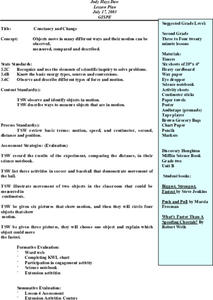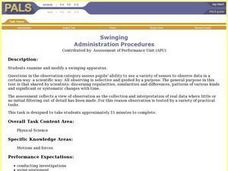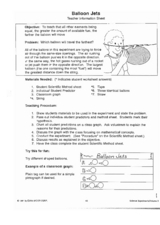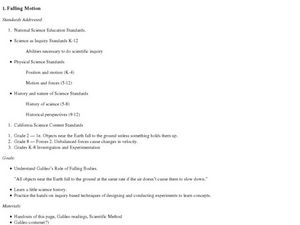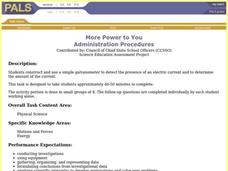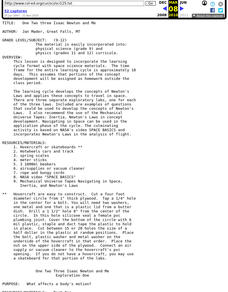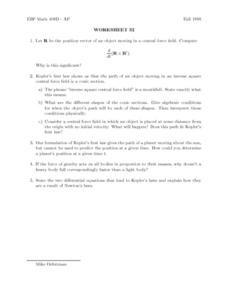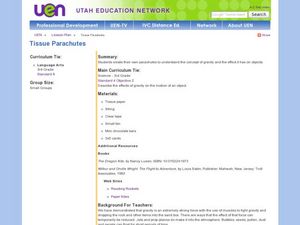Curated OER
Marvelous Magnets
Students identify and classify magnetic and nonmagnetic materials and metals. After determining which materials and metals are magnetic, students create a data table and classify items by two different criteria. Students e-mail various...
LABScI
Viscosity: The Fluid Lab
There's more to fluids than meet the eye—they include gases, liquids, and polymers, too! Scholars complete three hands-on activities exploring different properties of fluids. They explore viscosity by measuring the resistance, or...
Purdue University
Slow Boat Design
Don't be a drag. Learners work in groups to design boats that move slowly. The provided reason for the activity is that a fish caught on a fishing reel is pulling the boat, causing it to move too fast. The STEM activity teaches the class...
Curated OER
Rockets!!
Learners launch a rocket. In this laws of motion lesson, students discuss the forces of flight, how a plane flies and how a rocket gets off the ground. Learners watch a video about rocket launches, discuss Newton's Third Law...
Curated OER
Design Your Own Rube Goldberg Machine
Students participate in a culminating activity for a unit on Energy and Simple Machines. They are challenged to incorporate simple machines in to a complex mechanical system. While designing and testing their machine they will also...
Curated OER
Constancy and Change
Second graders investigate how objects can move in different ways. They move in different ways across the room and develop a class list of movement words. Students also conduct a measuring motion experiment, create a bar graph for the...
Curated OER
Parachutes: What a Drag
Sixth graders make 2 different kinds of parachutes and record and graph the time for each one for the different drag forces. In this parachute lesson plan, 6th graders compare the results to the rest of the class of each parachute and...
Curated OER
Swinging Observations
Students build a pendulum type swinging apparatus and make specific and selective observations using what they know about scientific observations. They look for regularities of movement, patterns, and systemic changes over time.
Curated OER
VECTORS
Ninth graders explore vectors. In this vectors lesson students complete a lab activity.
Curated OER
Extreme Acceleration
Young scholars explore the concept of acceleration. They determine the acceleration rate of a roller-blader and graph the results.
Curated OER
Forces in a Climb
Students use a NASA website to use a given formula to find acceleration and distance after a specific time and how it relates to engine propulsion.
Curated OER
Soda Straw Rocket Activity
Students construct a rocket using soda straw. For this physics lesson, students determine the nose cone length that produces the best rocket. They explain the importance of using a control in an experiment.
Curated OER
Balloon Jets
Students investigate how fuel amount affects the distance traveled by balloons. In this physics lesson, students collect data and create a pictograph. They interpret data and formulate a conclusion.
Curated OER
Falling Motion
Students design and conduct an experiment on Galileo's Rule of Falling Bodies. In this physics lesson, students collect and analyze data. They create a presentation and share it with the class.
Curated OER
Calibrating a Roverbot
Learners build and program a Lego Mindstorms Roverbot to travel for a given amount of time. They gather data on time versus distance traveled to determine a calibration constant for their robot, which relates time to distance.
Curated OER
More Power to You
Students construct a simple galvanometer in order to detect the presence of an electric current as well as determine the amount of the current. Activity is divided into two parts, first part as group work and second as individual.
Curated OER
One, Two, Three--Isaac Newton and Me
High schoolers experiment to develop understanding of Newton's Laws and how they apply to space travel in this ten day instructional activity sequence.
Curated OER
Wright Again: 100 Years of Flight
Aspiring aeronautical engineers demonstrate different forces as they construct and test paper airplanes. This lesson plan links you to a website that models the most effective paper airplane design, an animation describing the forces...
Hawaiʻi State Department of Education
Machines
What do science and dance have in common? Simple machines, work, and force! First, children discuss machines, wheels, inclined planes, and wedges. They create inclined planes with their bodies and make up dances about wheels and wedges....
Curated OER
Worksheet 32: Kepler's Law
For this math worksheet, young scholars are given 8 questions regarding Kepler's first law of motion. The questions include definitions, short essay explanations, and formulaic expressions.
Curated OER
Elements of Physics: Motion, Force and Gravity
Students research about different human space explorations conducted by NASA. In this physical science lesson, students discuss why space exploration is important. They write a paper about their thoughts on continuing NASA's space...
Curated OER
Finding Balance
Young scholars examine the relationships between force, mass and balance through the lens of clay sculpture. They discuss the definitions and concepts behind Newton's Third Law of motion then individually apply these principles to the...
Curated OER
FORCES, MOTION, AND ENERGY
Eighth graders engage in a variety of activities in order to investigate the basic concepts of physics. They read and answer questions in a written text. This is only one type of activity that is part of many others.
Curated OER
Motion and Gravity
Third graders make parachutes to learn about gravity and the science process. In this gravity lesson, 3rd graders create parachutes and observe their flight in air. Students discuss wind and gravity for the activity.
Other popular searches
- Elementary Force and Motion
- Force and Motion Experiments
- Science Force and Motion
- Motion and Force
- Unbalanced Force and Motion
- Force and Motion Activities
- Force and Motion Unit
- Force Motion Energy
- Force and Motion Lessons
- Science Force Motion
- Force Motion and Energy
- Motion Force and Gravity





